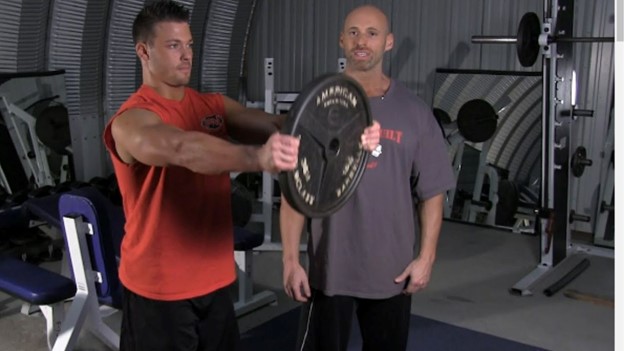1. Introduction:
Welcome to a journey of precision and shoulder strength .In this guide, we unveil an effective and unique technique for shoulder training: the Plate Front Raise. Achieve new heights in strength and definition by Prepare to unleash the power of your shoulders .
2. The Significance of Shoulder Training:
Shoulder training is essential for both functional fitness and aesthetics. Well-developed shoulders not only enhance your physique but also play a crucial role in various upper body movements, such as pulling, pushing, and lifting.
Neglecting shoulder training can lead to limitations and imbalances in overall strength and mobility.
3. Anatomy of the Shoulder Muscles:
Let’s recognize the anatomy of the shoulder muscles before plunging into the Plate Front Raise technique. The shoulder complex consists of three main muscles: the deltoids, comprising the lateral, anterior, and posterior heads.
The deltoids are responsible for sturdiness and shoulder movement ,making them a focal point in any shoulder training regimen.
4. The Plate Front Raise Technique:
The Plate Front Raise is an isotonic exercise that engages the lateral and posterior deltoids and the bracing muscles of the shoulder girdle while also targeting the anterior deltoid .
This unique technique involves centering on the movements that are calculated and precise muscle engagement, lifting it directly in front of the body and holding a weight plate with both hands .
5. Executing the Plate Front Raise:
To perform the Plate Front Raise:
- Hold a weight plate with both hands in front of your thighs, palms facing inward and Stand with your feet shoulder-width apart .
- grip your core for firmness and Keep a small bend in your elbows .
- Slowly raise the weight plate in front of you, keeping your arms straight but not locked out.
- Continue lifting until your arms are aligned to the ground or nearly higher, then lower the weight plate back to the beginning position.
- Do again for the desired number of repetitions, maintaining control and proper form all over.
6. Targeting Specific Shoulder Heads: A Comprehensive Approach:
It’s pivotal to target each head of the deltoids individually to attain balanced shoulder development. compromising a variety of exercises that bound and assert different areas of the shoulders make sure thorough development and minimize the risk of imbalances.
Some effective exercises for choosing specific shoulder heads include:
- Anterior Deltoid: Front Dumbbell Raise, Plate Front Raise
- Lateral Deltoid: Cable Lateral Raise, Lateral Dumbbell Raise
- Posterior Deltoid: Face Pulls, Rear Delt Flyes
7. Progressive Overload with Plates: Tailoring Your Shoulder Workout
Developing overload is the key to continuous strength gains and muscle growth. You challenge your muscles to adapt and grow stronger ,by gradually increasing the volume or resistance of your workouts over time.
For progressive overload in shoulder training plates provide an excellent tool ,allowing you to increase resistance in small accessions and tailor your workouts to suit your individual necessity and aims.
8. The Fire Within: Igniting Intensity and Emotion
Tap into the fire within and train with intensity and emotion to truly increase your shoulder training experience. Summon your inner strength,visualize your goals and push yourself beyond your limits with each repetation and set.
Directing your determination and passion into your workouts not only increases your physical performance but also promotes a deeper connection between muscle and mind, giving you power to achieve greatness and overcome hurdels .
9. Common Mistakes to Avoid:
Be mindful of the following mistakes ,while executing the Plate Front Raise:
-
Using Momentum:
Avoid swaying the weight plate or using momentum to lift it, as this reduces the advantages of the exercise and increases the risk of injury.
-
Lifting Too High:
To avoid unnecessary stress on the shoulder joints, lift the weight plate only to shoulder height or slightly above
-
Overarching the Back:
During the movement to prevent strain on the lower back ,keep your back straight and avoid arching it excessively.
-
Gripping Too Tightly:
To prevent excessive tension in the forearms and wrists maintain a relaxed grip on the weight plate.
10. Advanced Techniques for Intensifying Shoulder Training:
Consider incorporating advanced techniques, to increase the efficacy of the Plate Front Raise such as:
-
Paused Reps:
To increase time under tension and maximize muscle engagement, pause briefly at the top of each repetition .
-
Isometric Holds:
Hold the weight plate at the top of the movement for several seconds to challenge your shoulder strength and stability.
-
Drop Sets:
To push your muscles to fatigue and stimulate growth, perform multiple sets with decreasing weight .
11. Incorporating Variations for Comprehensive Shoulder Development
An influential exercise which also includes the Plate Front Raise,compromising variations can provide a more thorough shoulder workout. Some alteration that are effective include:
-
Lateral Raise:
Keeping your arms straight target the lateral deltoids, by lifting the weight plate or dumbbells out to the sides.
-
Dumbbell Front Raise:
To target the shoulders from a bit different angle, aim the front raise using dumbbells instead of a weight plate .
-
Cable Front Raise:
Provide sustained tension all over the movement and increase muscle activation by Using a cable machine to perform the front raise.
12. Final Thought :
In the end, to elevate your shoulder training regimen mastering the Plate Front Raise approach is the key .
By comprehending the importance of shoulder workout, performing the exercise with precision and control,and familiarizing yourself with shoulder anatomy, you can sucessfully develop and target your shoulder muscles for better stability, strength,and elegance.
Remember to train gradually,constantly, overload your muscles, and listen to your body to reach perfect results in your shoulder training journey.

